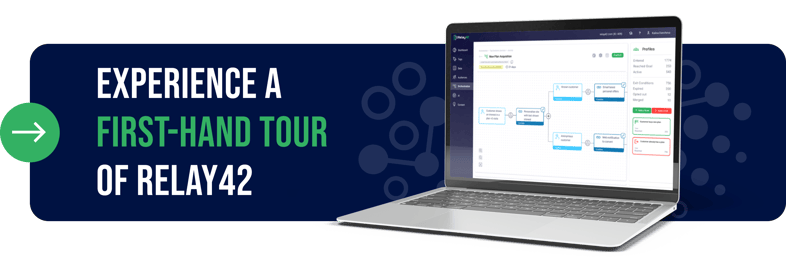5 Micro-Journeys to Boost Your Cross-Channel CX
by Relay42 on 22.1.2021

Table of Contents
- Using technology to deliver on seamless customer journeys
- Micro-journeys: stepping stones for a cohesive bigger picture
- Media spend optimization: catching the attention of the right target audience, at the right time
- Real-time remarketing: staying top-of-mind while your customers consider their options
- Conversion optimization: how to give prospects that final nudge to complete their transactions
- Effective upsell and cross-sell: recommending relevant products
- Customer retention upsurge: keeping your customers happy with 1:1 personalized service
- Prioritizing your micro-journeys: how to organize for maximum efficiency
- Checklist for micro-journey success
Using technology to deliver on seamless customer journeys
The marketing landscape was easier to navigate when there were just a few select channels for reaching your customers. As technology has continued to evolve at an exponential rate, however, the MarTech landscape has quickly become fragmented. In the frantic scramble to become king of the hill, marketers are grabbing hold of as many channels as they can, but often without an overall strategy to communicate a single, uniform message.
The result? They are spreading themselves too thin across multiple channels and their messaging (and CX) is becoming fragmented.
As more channels are added to the list, relevancy becomes a harder target for marketers to hit. How can you make your mark, manage your channels more efficiently, and ensure that your customers have a great experience, all while making good use of your budget?
Micro-journeys: stepping stones for a cohesive bigger picture
The truth is, there is no such thing as The Customer Journey. There are simply too many channels and choices. Instead, marketers and UX specialists are working with micro-journeys — stepping stones to the ultimate 1-to-1 experience. Working in micro-journeys gives you the room to tailor a journey to an individual, rather than trying to force individuals into a pre-made journey or campaign.
The most important part of creating seamless customer journeys is thorough examination and planning. This enables you to create an overall customer journey and experience that is fully optimized for your customers, from the first to the very last step.
This, coupled with technology, means that no matter which path your customers choose, you’ll always be there for them with the most fitting next-best-action to facilitate their interactions with you.
Media spend optimization
Catching the attention of the right target audience, at the right time
Challenge: Hooking customers
The first step in any customer journey is sparking an interest in your potential customer. But how do you specifically target those who are the best demographic for your product, and when?
Solution: Utilize partner and audience data
Combining partner and audience data (1st and 2nd party data) with your own data allows you to cast a far wider net. Once you’ve cast such a net, you can then sift through the relevant information to hyper-focus your marketing strategies and personalize at scale, as well as reduce media waste.
How a major FMCG brand optimized media spend and created relevant ads
Competition is always the number one concern in any industry. Delivering on the best products and services is only part of the equation when it comes to engaging with your target market. The other part of the equation involves boldness and creativity. By using data gathered from a survey, one FMCG brand targeted prospects by connecting their CRM, Facebook custom audiences, messenger ads, and chat in order to boost conversion of people who had intent to purchase products similar to theirs.
The Relay42 platform helped them match their CRM data with email addresses on Facebook, which enabled this brand to send specialized messages to these customer groups to facilitate their conversion.
- Results: -80% reduction of cost per lead
How an international airline used audience data to gain an additional relevant audience group
Simply casting your marketing net at will isn’t the ideal strategy. Even if you fill the net, is it the right demographic? Could you use your budget more wisely? Smarter marketing doesn't only reduce media spend — it can also make a significant impact on your KPIs.
One airline took audience data containing an audience interested in flights to a specific destination, compared it to the data of existing customers in their CRM, and qualified intent and interest to book based on the resulting overlap of data. The airline then sent out a personalized email campaign to the overlap group which catered to their specific interest in the destination. The result was as predicted — the airline found that they reached a far more interested and relevant group of customers than they would have without the hyper-focused targeting.
Results:
- +200% email open rate
- +170% click-through rate
Read about other airline micro-journeys here.
Real-time remarketing
Staying top-of-mind while your customers consider their options
Challenge: Keeping your prospects engaged through to conversion
Although the most difficult thing to do initially is to get the right people interested in your product, another challenging step is retaining the interest of your potential customers and not losing out to competing brands just before they’ve made their final decision to purchase. Catching prospects at the right time and serving them with relevant information is crucial if you want to stay top of mind.
Solution: Personalize content to give customers exactly what they’re looking for on the best channel for them
The use of an omnichannel marketing strategy augmented by agile technology can help your brand cover all bases when it comes to effective messaging to prospects.
How a national rail service delivered personalized content
A visit on your website shows interest in the products your brand has to offer. Should a consumer revisit your website, this indicates further interest and active evaluation on their part. When they return to your brand, showing them additional, relevant information can be just the push they need in order to fully commit to buying your product.
This rail service utilized our data management solution to serve a personalized homepage for users who indicated interest in particular subscriptions. In addition to serving personalized homepages, this brand also retargeted prospects through display ads and email at specific time increments, which provided crucial nudges to garner additional interest in their products.
Results:
- +776% CTR on personalized homepage
- +14.9% conversion rate uptake
Conversion optimization:
How to give prospects that final nudge to complete their transactions
Goal: Successful customer transactions
The 1:1 relevance of each micro-journey is what makes for the optimal overall journey and experience. From your first touch with a customer to the very second before they purchase your service or product, you need the right technology and channels to drive your potential customers towards finally converting. Not only that, but you need to be able to deploy next-best-actions with that technology to cater to your customers' needs in real-time.
Challenge: Distracted prospects, disrupted conversions
Everyday life comes with everyday distractions, and that’s certainly not an exception for your customers. Whether it’s a phone call or an emergency business meeting, it doesn’t matter: when your customers get distracted they don’t convert. So how can you direct these customers back to your brand when they’ve turned their attention elsewhere?
Solution: Expand your reach across other channels
By taking into account their previous behavior, you can plot the next-best-channel or next-best-action to send a well-timed reminder for them to finish their transaction.
How one airline regenerated interest from abandoned bookings
In the travel industry, many consumers who are interested in a holiday perform preliminary searches in order to gather information. Many of these searches end up abandoned, as these consumers don’t intend to book until later.
To address this issue and to facilitate conversion, this airline sequenced their nudges with precision. First through cost-efficient emails, and then with more personal targeted push messages based on departure dates.
Not only did they succeed in encouraging more customers to book, but they also eliminated budget waste.
- Result: -75% in push messages, which led to significant reduction in costs
Effective upsell and cross-sell recommending relevant upsell products
Challenge: Enriching customer journeys beyond initial purchases
Although the customer journey appears to finish when the ‘deal is sealed,’ marketers know it extends far beyond the initial transaction. But how can you encourage additional purchases without annoying them?
Solution: Offer interesting next-best-offers or actions
By reaching out to your customers through multiple channels based on their previous actions, you can enhance their overall experience by recommending next-best-offers and actions for them to take after they’ve converted. Your customers will certainly appreciate the effort that you put into guiding them every step of the way when interacting with your brand.
How one insurer prequalified a group of customers for upsell
When consumers purchase insurance, it is usually on a long-term basis. This means that insurance providers must work hard in order to retain a loyal customer base. The Relay42 platform enabled this insurer to identify a group of people with good customer scores — people who rated this insurer positively; logic assumes that since this group is satisfied with their previous interactions, they are more likely to convert.
By using the Relay42 to coordinate customer live chat, their central profile system and product inventory, this insurer ran an upsell campaign for free product eligibility consultations solely to this group. The insurance company thus reduced media spend while gathering valuable information, which was then stored in the platform to be used for future personalized display retargeting.
- Result: +11% incremental sales uplift
Customer retention upsurge: Keeping your customers happy with 1:1 personalized service
Challenge: Maintaining customer satisfaction and keeping competitors at bay
Loyalty isn’t free. Today's businesses understand that they must prove they can provide added value time and time again, and that they must also continually convince customers that they add greater value than their competitors.
Solution: Personalize your outreach
The optimal journey for your customers is one that keeps feeding back into interest and purchase. They should feel like you’re anticipating their needs and understanding their intent, no matter which journey they take. This creates a win-win situation: your customers receive the right service when they need it, and you gain their loyalty.
How one utility company offered valuable services to their existing customers
In many industries, especially utilities, customer retention is a hot issue. It simply isn’t enough to get contracts signed — you have to eliminate the wandering eye and keep the focus on how you can provide lifetime value for your customers.
This utility company connected its proprietary content management system (CMS), display advertising, search, and web analytics with the Relay42 platform in order to form a cohesive solution that served pertinent information in real-time to their customers, across all channels. In turn, they sharpened their marketing by being present wherever their customers went.
- Result: +4.2% average contract value and customer retention
Prioritizing your micro-journeys how to organize for maximum efficiency
Although the customer journey starts at initial interest and culminates with a loyalty loop, you shouldn’t necessarily prioritize your micro-journeys in the same way. Instead, you should consider the level of complexity for each, based on the existing technology and teams you have in place — as well as their respective business value.
The level of complexity combined with the business value gives you an accurate representation of which micro-journeys you should get started with. This low-hanging fruit can give your team valuable time to get familiarized with the platform, plus deliver on quick results.
Once your team has grown accustomed to the capabilities of your platform, the focus can shift to more complex journeys that build on business value and better customer experience. By adding layers to the previous micro-journeys, you gain the stepping stones to success.
Checklist for micro-journey success
But before jumping in with both feet, we suggest taking a step back to organize your thoughts and carefully examine what exactly it is you wish to achieve. Here’s a quick checklist of useful questions to think about before taking the plunge.
What to consider for your micro-journeys:
- What do you want to achieve?
- Who do you want to interact with?
- Why do you want to get in touch with these people? Where in the funnel is your target audience?
- Is your goal awareness, engagement, conversion, or nurturing?
- On which channel(s) will you find your target audience? How many channels do you want to orchestrate?
- When are you going to reach out to them? And how often? How much do you want to spend?
- What data do you need in order to roll this journey out?
You May Also Like
These Related Stories
.jpg)
Toolkit: Customer Journey Visualization Tool

Getting Ready for the Next Level of Customer Journeys with Relay42 Automated ML (2/2)


